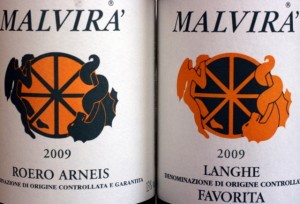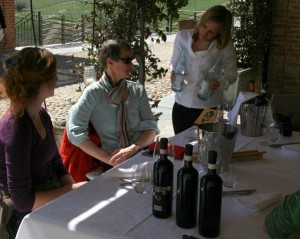 There are some days when everything is just perfect – the spring sunshine, the countryside emerging from a long hard winter, the place, the people. Our visit to Malvirà was one of those days. As with quite a few wineries in Piemonte, the building could be just a rather larger house from the outside. But it does have a fabulous view and, below, most of a new winery in construction beneath the apparent domesticity.
There are some days when everything is just perfect – the spring sunshine, the countryside emerging from a long hard winter, the place, the people. Our visit to Malvirà was one of those days. As with quite a few wineries in Piemonte, the building could be just a rather larger house from the outside. But it does have a fabulous view and, below, most of a new winery in construction beneath the apparent domesticity.
To reach the town of Canale you leave Alba and with it the world-famous red wines of the Langhe. The soil changes to a lighter, sandier, composition and it is immediately noticeable that the agriculture is more mixed. There are vines but there is also fruit (especially peaches), animals, ordinary fields, light industry. This is the Roero, home of the important Piemontese white, Arneis, more Nebbiolo, Barbera and Dolcetto and some other interesting local varieties. And after the almost uniformly ‘red’ diet of the Langhe, it is refreshing to have excellent whites to taste.
But before we get to the wines, we have to celebrate the weather and the arrival of spring.
Malvirà shares a hillside with the beautiful hotel, Villa Tibaldi, very smart indeed and with a great restaurant.Tasting on the terrace in the spring sunshine in congenial company is either exactly the thing to do (after all wine is supposed to be pleasurable!) or very unprofessional. There is much more to be written about this subject in another post. But I like to think that you can continue to have some level of objectivity if you concentrate hard to evaluate the wines even in a setting like this. But then I would think that – it’s in my interest.
 Malvirà exploits the sandy soils of the Roero for the four good whites which we tasted. Favorita 2009 –Favorita being the same grape as the much more widely known Vermentino – is delicately floral, with quite exotic fruit including a hint of citrus, medium in weight and with good acidity. A good aperitivo. The standard Arneis 2009, 13?, has lovely aromas of white-fleshed fruit and is slightly nutty with a bitter element, so typical of Italian whites. The grape has been documented in the area since 1400. This example initially tasted quite low in acidity but that was probably more due to the fullness of the wine with its thirteen degrees of alcohol. Yet more structured is the Arneis from the single vineyard Trinità (2008). 10% of this has done time in French oak with additional richness from stirring the lees. In the mouth, the wine is fuller, with more tropical fruit, rounded, very good indeed. Finally, in the whites we tasted Treuve 2005, 14?, the three grapes being rather more international in character, Sauvignon Blanc (40%), Chardonnay (40%), Arneis (20%). This has aged well, with a powerful nose of exotic fruit and butter, very rounded, very stylish, impossible to place because of the three grapes used together.
Malvirà exploits the sandy soils of the Roero for the four good whites which we tasted. Favorita 2009 –Favorita being the same grape as the much more widely known Vermentino – is delicately floral, with quite exotic fruit including a hint of citrus, medium in weight and with good acidity. A good aperitivo. The standard Arneis 2009, 13?, has lovely aromas of white-fleshed fruit and is slightly nutty with a bitter element, so typical of Italian whites. The grape has been documented in the area since 1400. This example initially tasted quite low in acidity but that was probably more due to the fullness of the wine with its thirteen degrees of alcohol. Yet more structured is the Arneis from the single vineyard Trinità (2008). 10% of this has done time in French oak with additional richness from stirring the lees. In the mouth, the wine is fuller, with more tropical fruit, rounded, very good indeed. Finally, in the whites we tasted Treuve 2005, 14?, the three grapes being rather more international in character, Sauvignon Blanc (40%), Chardonnay (40%), Arneis (20%). This has aged well, with a powerful nose of exotic fruit and butter, very rounded, very stylish, impossible to place because of the three grapes used together.
At Malvirà we were very ably hosted by Mollie (marketing) and Evan (right), who came to work with grapes but was currently painting parts of the new winery – such is life. Evan is English – you can just about see the Majestic logo on his shirt – and talked us through the winemaking process. We also got the chance to meet owner Roberto over part of lunch. They genuinely seem a very happy crew.
Over lunch, we tasted the reds in quick succession. San Michele 2006, Barbera d’Alba, spends 20 months in barriques, one-third of which are new. It has good perfumed fruit, a mid-weight Barbera with the characteristic good acidity. Langhe Nebbiolo 2006 is aged for a total of three years and has the characteristic cherry perfume. We noted the paleness of the wine – apparently, Nebbiolo is even paler than usual in good years such as this. There is nothing pale however about Renesio, Roero Riserva DOC 2005. This Nebbiolo spends two years in wood and another two in bottles before being released. Despite its riserva status, it’s very drinkable, with that characteristic combination of cherry and oak-related aromas.
We finished with a local speciality, a version of the lightly alcoholic sweet wine, typically made from Moscato grapes but here from the red grape, Brachetto. It is sold as Birbet, characteristic of the Acqui area, and very attractive it is too with its gorgeous colour, bright red fruit, sweetness, very slightly almondy and under 6? of alcohol.&#
160;
Many thanks to Mollie and Evan for their hospitality and time. The standard Arneis is available from Waitrose – which of course is where I came across it first. Malvirà is one to follow, even when the sun doesn’t shine.
Return to Piemonte homepage







Comments are closed.